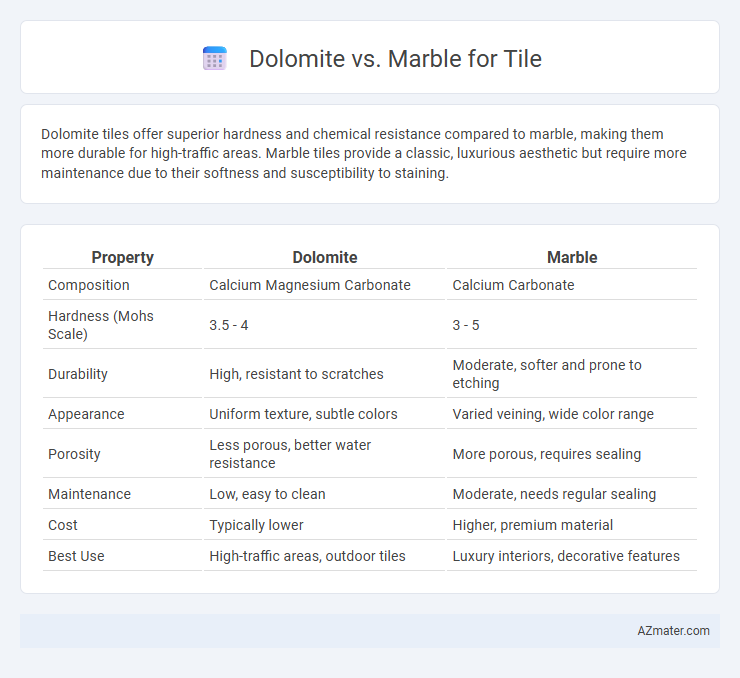Dolomite tiles offer superior hardness and chemical resistance compared to marble, making them more durable for high-traffic areas. Marble tiles provide a classic, luxurious aesthetic but require more maintenance due to their softness and susceptibility to staining.
Table of Comparison
| Property | Dolomite | Marble |
|---|---|---|
| Composition | Calcium Magnesium Carbonate | Calcium Carbonate |
| Hardness (Mohs Scale) | 3.5 - 4 | 3 - 5 |
| Durability | High, resistant to scratches | Moderate, softer and prone to etching |
| Appearance | Uniform texture, subtle colors | Varied veining, wide color range |
| Porosity | Less porous, better water resistance | More porous, requires sealing |
| Maintenance | Low, easy to clean | Moderate, needs regular sealing |
| Cost | Typically lower | Higher, premium material |
| Best Use | High-traffic areas, outdoor tiles | Luxury interiors, decorative features |
Understanding Dolomite and Marble: Key Differences
Dolomite is a sedimentary carbonate rock composed primarily of the mineral dolomite, known for its resistance to acid and durability, making it suitable for high-traffic tile applications. Marble, a metamorphic rock formed from limestone, features a distinctive crystalline structure and vein patterns, offering a luxurious aesthetic but is more prone to scratching and acid damage. Key differences include dolomite's higher hardness and chemical stability versus marble's enhanced visual appeal and slightly softer surface, influencing their performance and maintenance as tile materials.
Origins and Composition of Dolomite and Marble Tiles
Dolomite tiles originate from the mineral dolomite, composed mainly of calcium magnesium carbonate, which provides superior hardness and resistance compared to marble. Marble tiles are formed from recrystallized limestone, composed primarily of calcium carbonate, giving them a softer surface with distinctive veining patterns. The differences in mineral composition directly influence durability, appearance, and suitability for various tile applications.
Visual Appeal: Color, Patterns, and Texture
Dolomite tiles offer a softer, more subtle palette with neutral tones and gentle veining, creating a refined and understated elegance ideal for minimalistic and modern designs. Marble tiles showcase a wider range of vibrant colors and dramatic, intricate veining patterns that enhance luxury and visual interest in high-end interior spaces. The texture of dolomite is typically matte or honed, providing a smooth, muted finish, while marble often features a polished surface that amplifies its rich color depth and glossy appeal.
Durability and Hardness Comparison
Dolomite tiles exhibit superior durability and hardness compared to marble, making them more resistant to scratches and wear in high-traffic areas. The Mohs hardness scale rates dolomite around 3.5 to 4, whereas marble typically falls between 3 and 3.5, indicating dolomite's enhanced strength. This increased hardness translates to better longevity and lower maintenance for dolomite tile installations.
Maintenance Requirements for Dolomite vs Marble
Dolomite tiles require less maintenance compared to marble due to their higher resistance to scratches, stains, and acids, making them ideal for high-traffic areas. Marble tiles are more porous and susceptible to etching and staining, necessitating regular sealing and careful cleaning with pH-neutral products. Choosing dolomite minimizes long-term upkeep costs while marble offers classic elegance that demands diligent care to preserve its appearance.
Application Suitability: Where to Use Each Stone
Dolomite tiles excel in high-traffic areas like kitchens and bathrooms due to their superior hardness and resistance to etching compared to marble. Marble tiles are ideal for low-moisture environments such as living rooms and bedrooms, where their luxurious appearance and smooth texture can be best preserved. Choosing between dolomite and marble depends on balancing durability needs with aesthetic preferences in specific applications.
Cost Analysis: Dolomite vs Marble Tiles
Dolomite tiles generally cost less than marble tiles due to their lower mining and processing expenses, making them a budget-friendly option for large-scale projects. Marble tiles, prized for their luxurious appearance and unique veining, often carry a higher price tag driven by extraction difficulties and transportation costs. When considering long-term value, marble's durability and timeless elegance may justify the initial higher investment compared to dolomite's affordability and adequate performance in moderate-traffic areas.
Pros and Cons of Dolomite Tiles
Dolomite tiles offer excellent durability and resistance to etching compared to marble, making them suitable for high-traffic areas and kitchens. They have a subtle, natural appearance with fewer color variations, providing a consistent aesthetic but less versatility in design. However, dolomite is slightly less heat-resistant than marble and may require periodic sealing to maintain its longevity and appearance.
Pros and Cons of Marble Tiles
Marble tiles offer timeless elegance and natural veining that enhances interior aesthetics, but they require regular sealing to prevent stains and etching from acidic substances. Their durability suits low-traffic areas, though they are softer and more prone to scratching compared to dolomite tiles. Maintenance costs and susceptibility to moisture damage are significant factors to consider when choosing marble for flooring or wall applications.
Which is Better for Your Project: Dolomite or Marble?
Dolomite tiles offer superior durability and resistance to scratches compared to marble, making them ideal for high-traffic areas and outdoor projects. Marble provides a classic, elegant appearance with unique veining patterns but requires more maintenance due to its porous nature and susceptibility to staining. Choosing between dolomite and marble depends on balancing the desired aesthetic appeal with the level of durability and upkeep your specific project demands.

Infographic: Dolomite vs Marble for Tile
 azmater.com
azmater.com